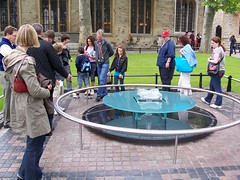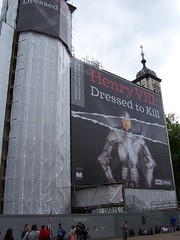 What trip to London would be complete without a vist to the Tower of London? Even though we plan to be here for a few years we thought it prudent to get our trip in as soon as possible, and when we found that we could go two-for-one with our train tickets we decided to go one sunny weekend.
What trip to London would be complete without a vist to the Tower of London? Even though we plan to be here for a few years we thought it prudent to get our trip in as soon as possible, and when we found that we could go two-for-one with our train tickets we decided to go one sunny weekend.The Tower looks very historic in amongst its surroundings. Tower Bridge is obviously nearby, but it only dates back to Victorian times. In contrast, the Tower has been around since the 11th century.
The main tourist entrance is rather traditional. It is the gate that prisoners left on the way to their beheading on Tower Hill, and also the same gate they had their bleeding corpse dragged through on their way to their headless, communal grave.
As we walked through the gate, we arrived just in time for the guided tour. The tour is given by one of the yeoman guards, who are all ex-military men. To become a guard you must have an impeccable record -- at least ten years continuous service without a blemish. Or, as our guard put it, "ten years of undetected crime". The guards tell you all kinds of stories, and it's easy to forget they were once sergeants. That is, until they give the foreigner who is interpreting for her friend a bollocksing for talking when he is, and then send them to the back of the group.
Apart from the scariness, the guards are full of colourful stories. They have the history of the place down, and can recite any number of gory stories about all the landmarks around the place. I don't remember any particular story standing out -- they all seem to blend into one, which goes a little like this:
Famous person, possibly of noble origin, incurs the anger of the King and is taken to the Tower. They are then kept prisoner there for some long period of time, living in comfort as befits their status, before they are then either taken to Tower Hill and beheaded, or released.
 One example everybody knows about is Anne Boleyn, but it turns out she wasn't actually beheaded like everybody else. She instead chose to be beheaded with a long sword in the grounds of the Tower itself. This method of beheading was so effective that apparently she didn't realise she was dead, and her mouth kept moving even while her head was held up to the crowd. There is now a glass pillow where she and other former favourites of the King met their end.
One example everybody knows about is Anne Boleyn, but it turns out she wasn't actually beheaded like everybody else. She instead chose to be beheaded with a long sword in the grounds of the Tower itself. This method of beheading was so effective that apparently she didn't realise she was dead, and her mouth kept moving even while her head was held up to the crowd. There is now a glass pillow where she and other former favourites of the King met their end.Not everybody was as lucky as Anne to die swiftly. There was one unfortunate fellow who decided not to tip the axeman (the money axemen received from their charges was the only payment they got for doing the job. Essentially, you were paying them to do a good quick job). Instead of the axe landing cleanly in his neck, it instead missed and embedded itself in his shoulderblade (to which the man is reported to have turned his head and said, "if you do that again I may not be able to keep still"). I suspect this story may have been embellished somewhat, as it kept going in almost comic fashion: the axe apparently hit every other area around the neck until, one suspects almost by luck, it hit him in the neck. And didn't go through. Eventually the axeman is said to have pulled out a knife and sawn the head off with that.
There was also the tale of the two princes, who stood in the way of Richard III taking the throne. Although they were to have been trained in how to be a king, they instead went missing and were eventually found in skeleton form underneath some stairs. We saw said stairs and visited the room in which they were kept, and although there is no direct evidence that Richard was behind it, it all seems rather suspicious and he seems to be the natural villan. They didn't mention this when we visited York; indeed, they were all rather fond of Richard. This may sound strange unless you know that York is his home town.
It's not all blood and gore at the Tower; there are also the crown jewels. We queued up like good British citizens and eventually found ourselves in front of some very shiny jewels. Some of them were quite impressive, such as the Sovereign's Orb but we particularly liked Queen Victoria's second crown, which she wore with her widow's veil after Albert died. It was very small -- maybe the size of two fists -- and Leah thought it was cute.
 There is also currently an exhibition of Henry VIII's suits of armour. We didn't get time to do anything more than the highlights of this, and I can report that while Henry was quite slender in his early days, by the time he died he was a porker. He probably never wore the last suit of armour built for him, which is just as well because it must have weighed a ton. The most amusing thing was the elongated codpiece, which was supposed to make him look powerful but would have really just made it difficult to go through doors sideways.
There is also currently an exhibition of Henry VIII's suits of armour. We didn't get time to do anything more than the highlights of this, and I can report that while Henry was quite slender in his early days, by the time he died he was a porker. He probably never wore the last suit of armour built for him, which is just as well because it must have weighed a ton. The most amusing thing was the elongated codpiece, which was supposed to make him look powerful but would have really just made it difficult to go through doors sideways.The exhibition was taking place in the White Tower, the original Tower of London. It could apparently have been seen for miles around, whereas nowadays it's not even visible from the outside unless you know where you're looking. We weren't allowed to take pictures of the inside, which was rather annoying, but if you imagine a cold draughty building with large open rooms and enormous fireplaces, you'll probably have the right picture. The fireplaces had interesting chimneys; the smoke would take a wandering path through the walls before exiting at some vent on the side, which dispersed the smoke and prevented attackers from knowing if there was anybody home.
However, the best thing about the White Tower was the royal throne room -- by which I mean the royal dunny. It had a door which must have been a luxury, as the other ones didn't. They must have been cold and breezy, and apparently they discharged directly into the moat. Archeologists have said it was the worst cesspit they'd seen (don't ask me how they know).
And finally, the thing everybody knows about the Tower is the ravens. Yes, we saw ravens, and to be honest they were a bit of a disappointment. They hopped around the grounds, and sometimes stood so still I thought they were fake ones. But as the legend goes, if there aren't seven ravens in the grounds at all time, the White Tower will crumble to dust, the King will die, and a great tragedy will befall England. So all in all, I'm glad they decide to stick around.
And if you were feeling sad for the people that were buried anonymously in that collective grave, you will be gladdened to know that Queen Victoria did too, and had them exhumed and reburied in individual graves inside the Tower's chapel.
Take a look at our photos.
No comments:
Post a Comment